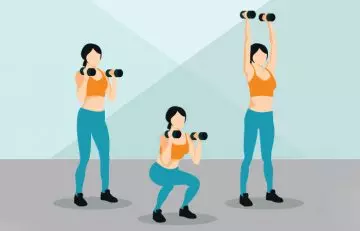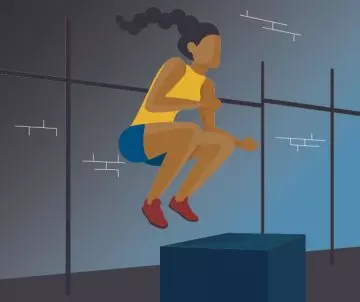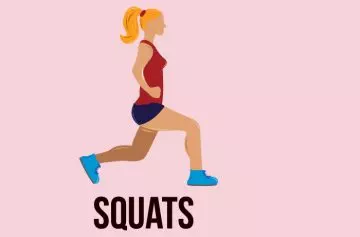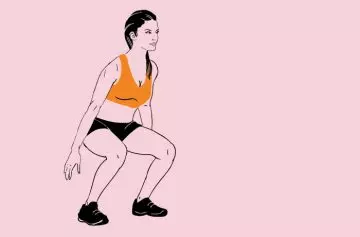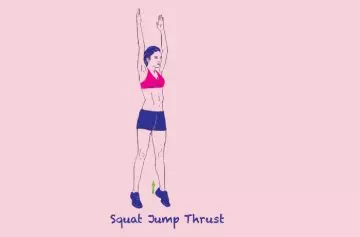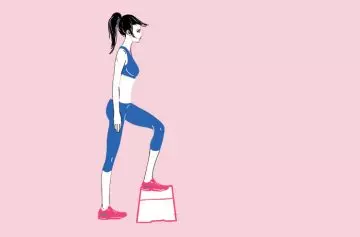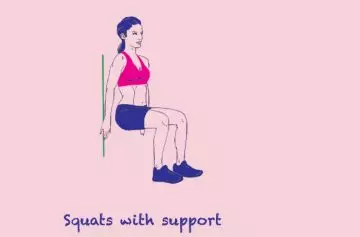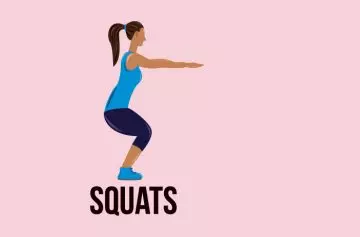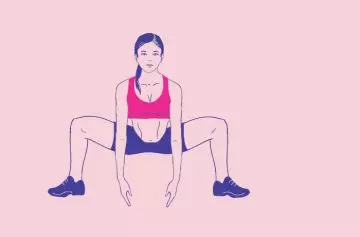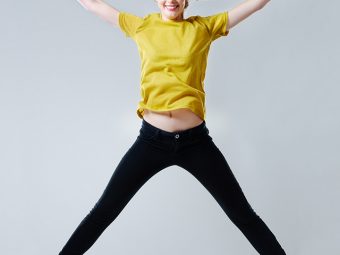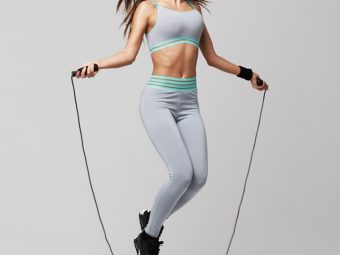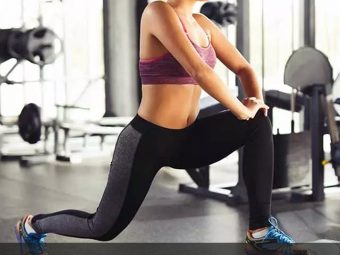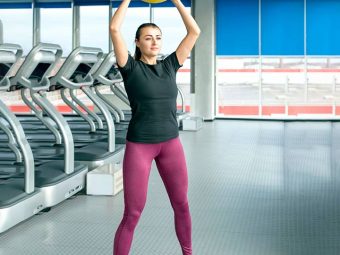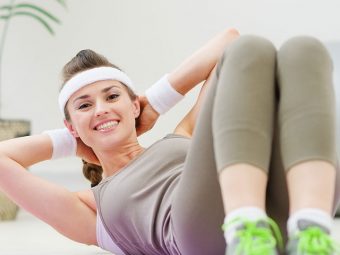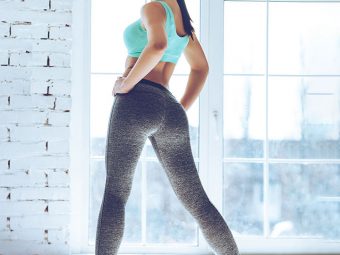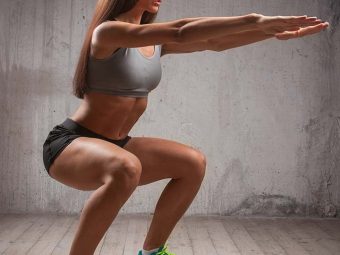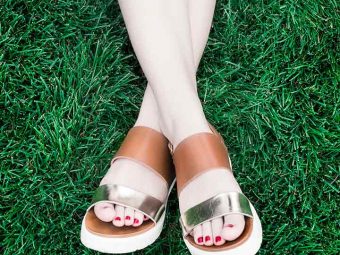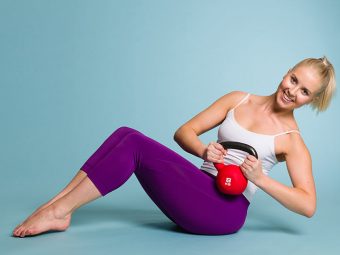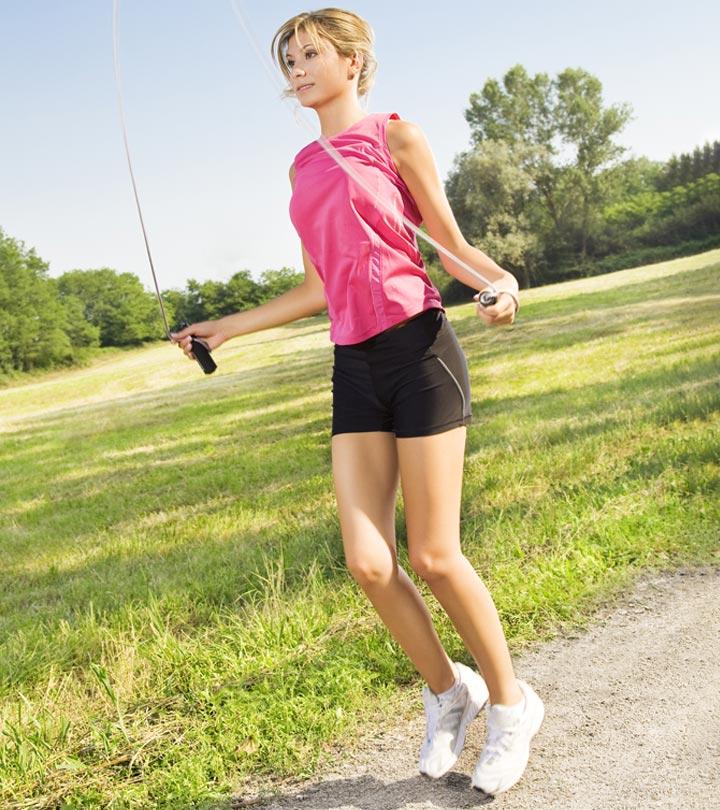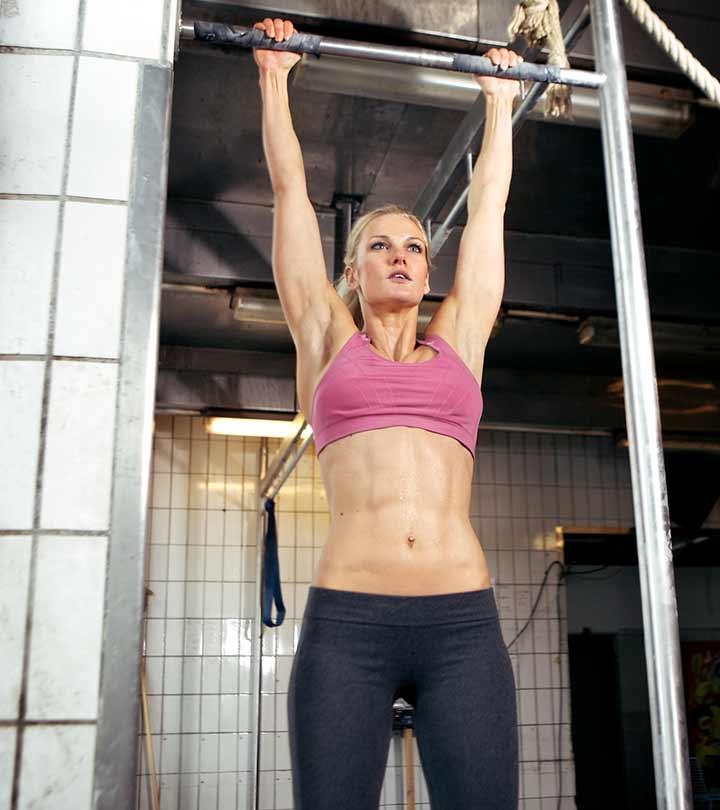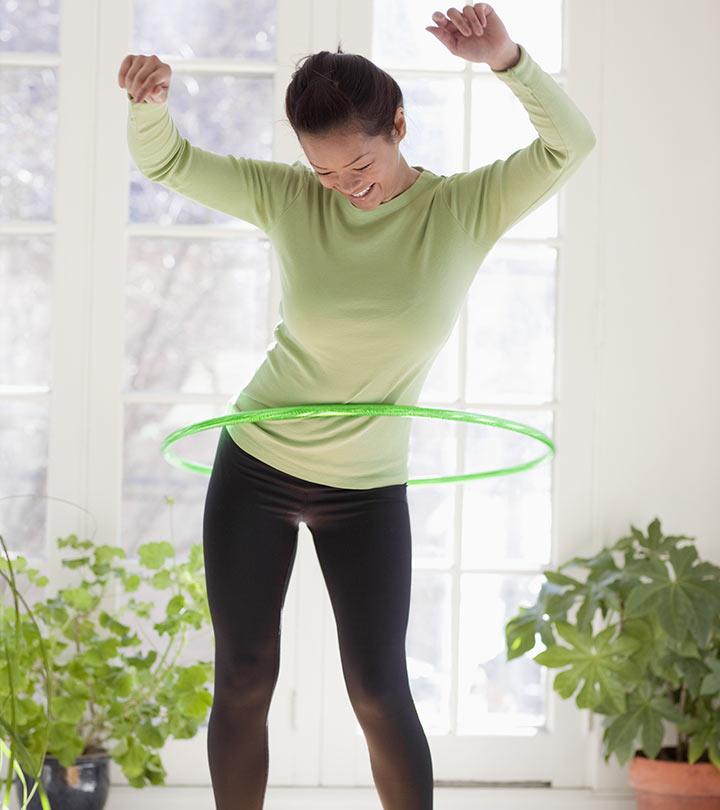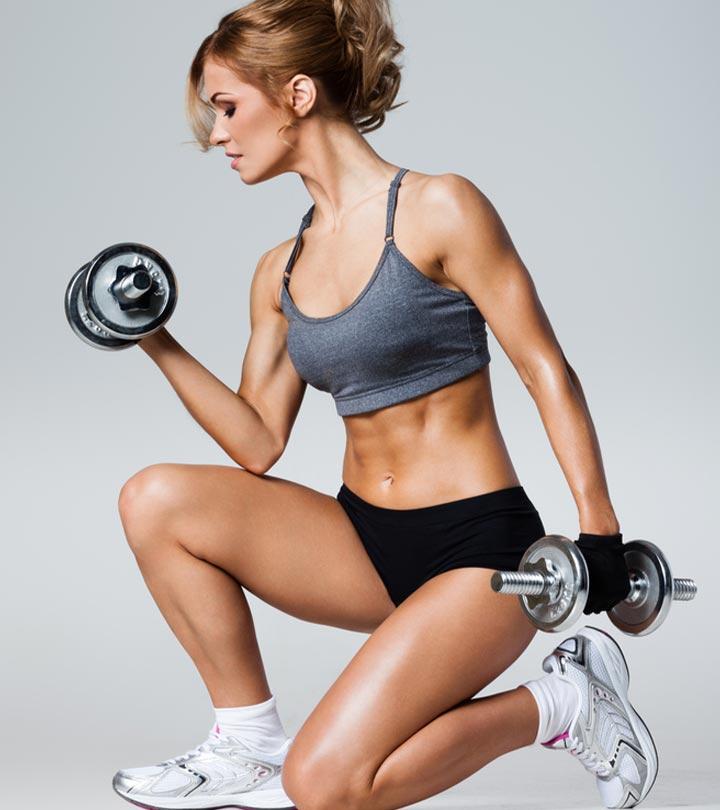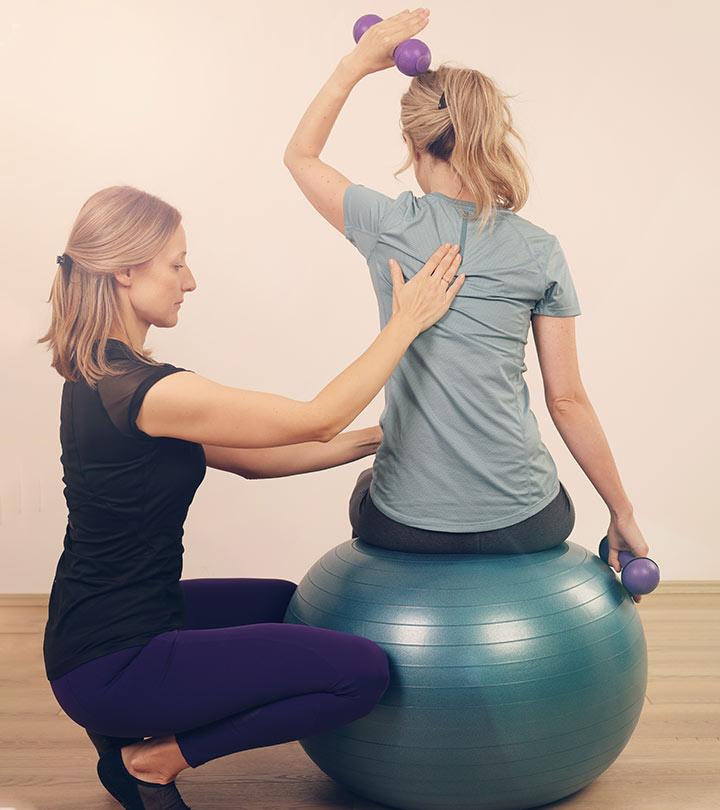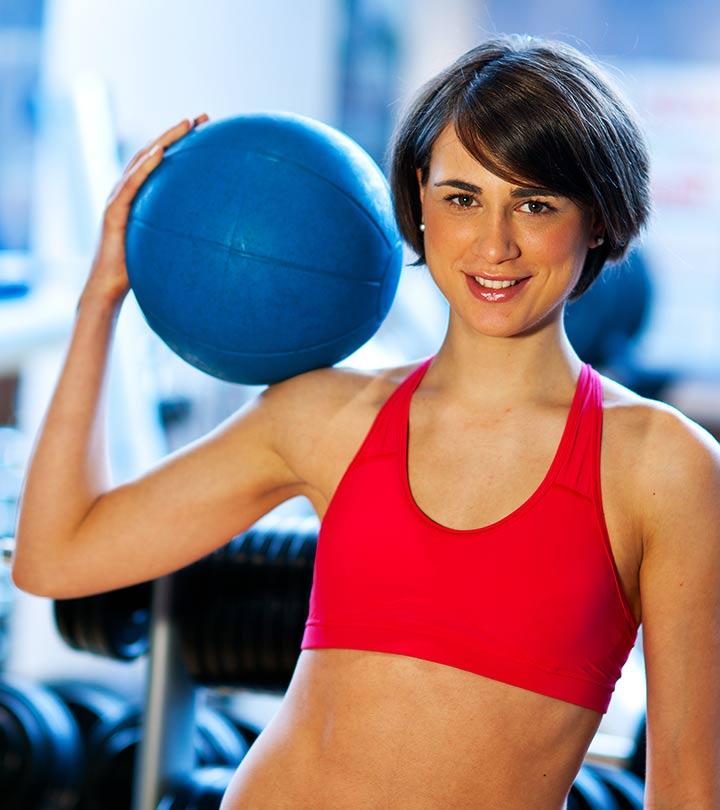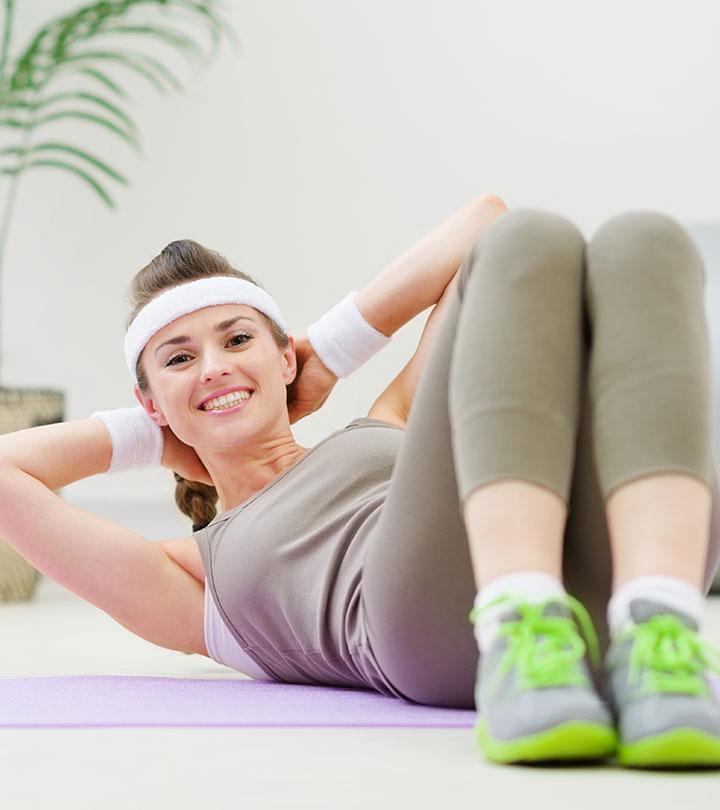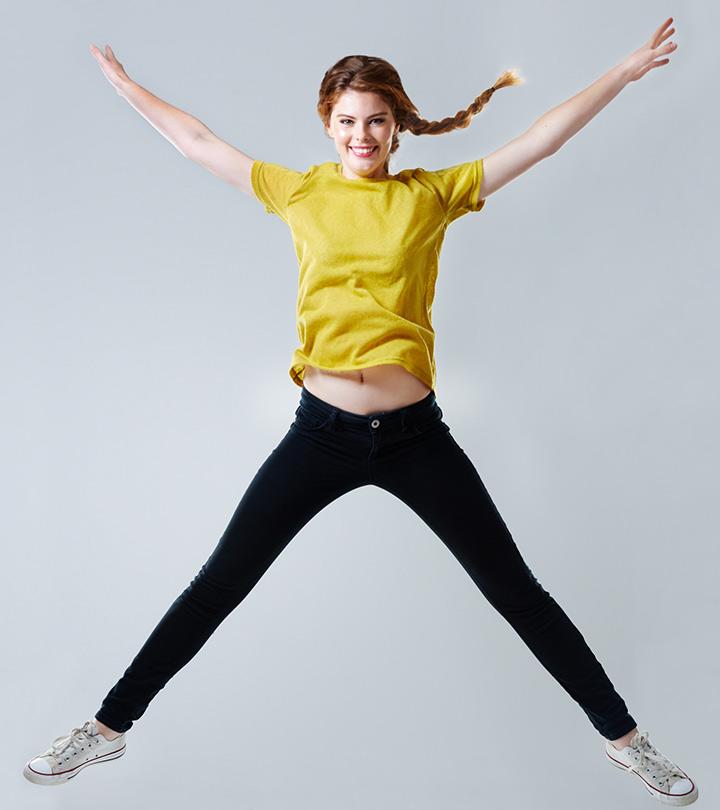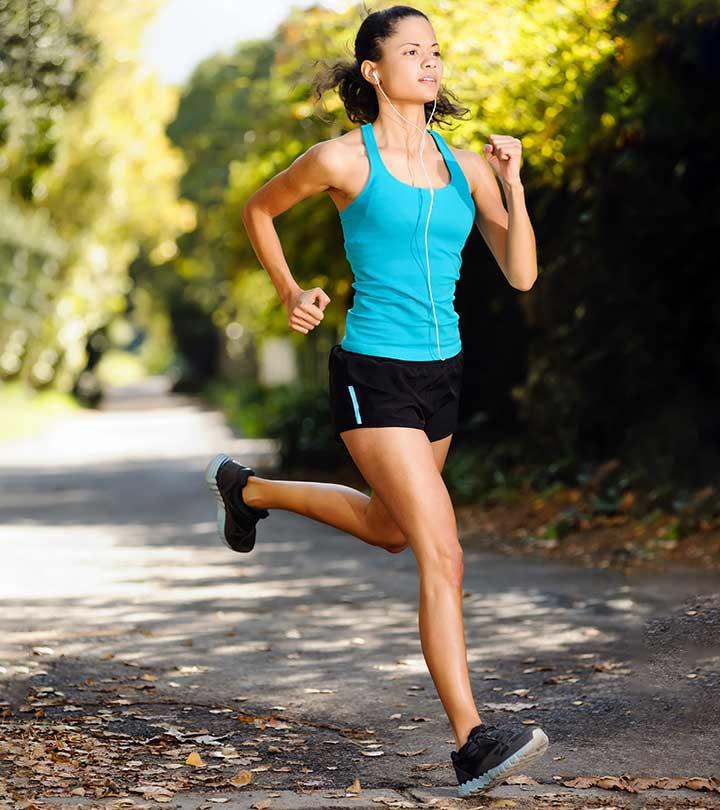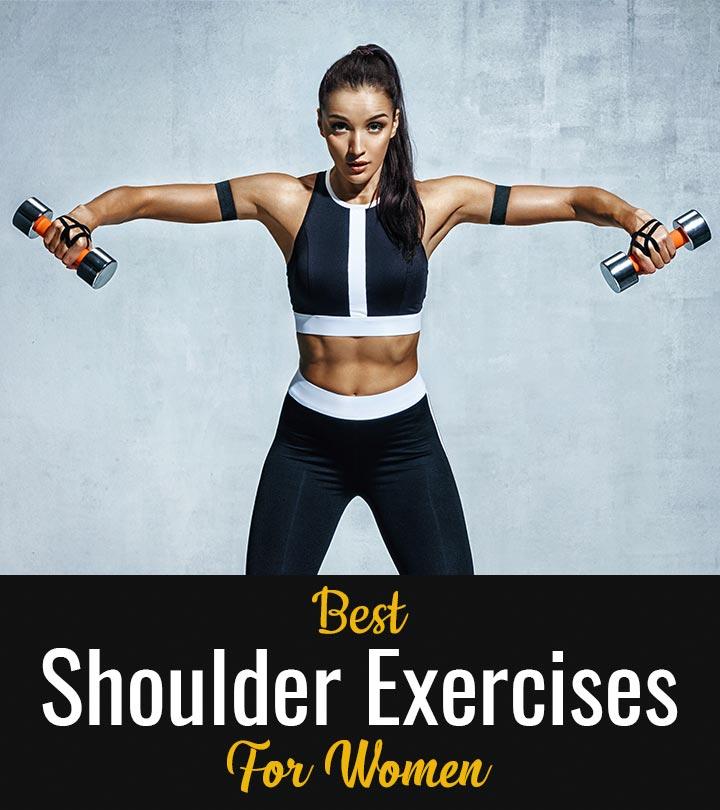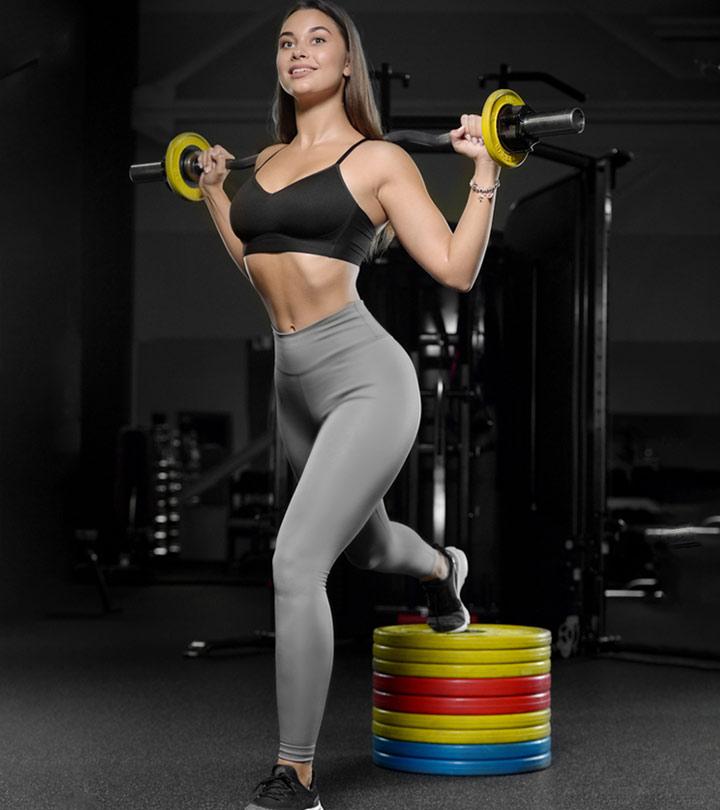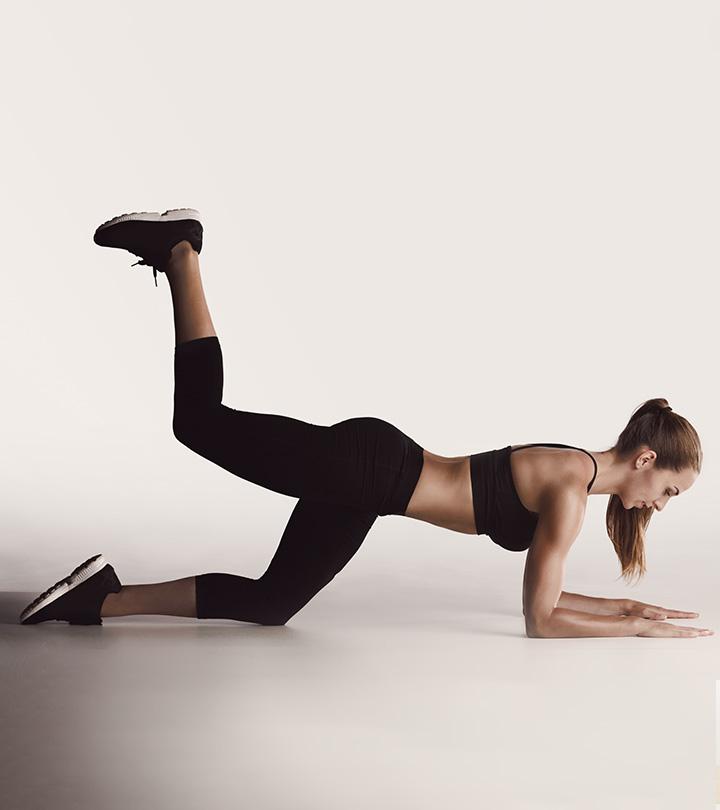How To Do Jump Squats Properly? Benefits And Types
Indulge in different variations of this high-intensity exercise to sweat out those pounds!

Image: iStock
Take your squats game to the next level with jump squats. The benefits of jump squats are many. They are a form of high-intensity exercise that targets the glutes, hamstrings, quads, and lower abs. In other words, they are a great lower body exercise. They even help whittle away fat, strengthen the thighs and hips, and improve balance (1), (2), (3). Read on to know how to do jump squats properly, their benefits, and their variations. Scroll down!
 Workout Blueprint: Jump Squats
Workout Blueprint: Jump Squats- Frequency: 3-4 times a week
- Benefits: Tone and strengthen the thighs and hips and improve balance
- Equipment Needed: Dumbbells and a box
- Space Required: Small area
- Assistance Required: No
- Who Should Avoid: Anyone who has recently undergone surgery or with poor joint conditions like arthritis.
In This Article
How To Do Jump Squats Properly
To begin, stand in front of a full-length mirror. Bend your knees a little, making sure that your spine remains upright.
Step By Step Guide To Do Jump Squats
- Stand straight with your feet shoulder-width apart, hands by your side, chest up, shoulders rolled back, chin up, and look ahead.
- Push your buttocks out, bend your knees, and squat down or assume a sitting position. Your knees should not overshoot your toes. Bend slightly forward to prevent your lower back from curving and getting hurt.
- Bring your palms together as you squat down.
- While getting up, propel your body upwards and jump. Throw your hands down to generate force.
- Land gently on the floor and squat down. Bring your palms together, making sure your knees are not caved in (this causes injury) and not overshooting your toes.
- Do 3 sets of 15 repetitions each.
 Quick Tip
Quick TipAdding jumping squats to your leg and glutes exercise routine can help you reap the benefits listed in the next section.
Jump squats tone many muscle groups. Check out the section below to know more about them.
Muscles Worked While Doing Jump Squats
Jump squats primarily target the lower body and engage various muscle groups. These include:
- Quadriceps: These muscles help extend the knees during the upward jump phase.
- Hamstrings: They play a role in bending the knees and extending the hips.
- Glutes: They are activated when you extend the hips during the upward motion of the jump and the landing phase.
- Calves: They help you push off from the balls of your feet and propel you into the air.
- Core: They help stabilize your torso during the squat and jump and help you maintain proper form.
- Adductors: They help stabilize your legs during the squatting and landing phases.
Adding jumping squats to your leg and glutes exercise routine can help you reap the benefits listed in the next section.
Jump Squat Benefits
Jump squats have a variety of health benefits. They help build and tone the calves, glutes, hamstrings, and quadriceps, and also improve core stability. They have other benefits as well. We have listed some important ones here.
1. Burn Calories And Fat
Jump squats can help increase your metabolic rate, which is the rate at which the body burns calories at rest. Doing 30 jump squats burns about 100 calories, depending on your current weight and intensity of the exercise. Many women tend to accumulate fat in the lower body, which is linked to many health issues. Adding jump squats to your routine will help in calorie burning and shedding fat from the lower body.
2. Tone The Butt, Legs, And Ab Muscles
Jump squats are a plyometrici XA type of exercise involving fast and repeated stretching movements within short periods to increase muscle strength and flexibility. version of normal squats. This high-intensity exercise helps tone the leg and butt muscles.
3. Maintain Mobility And Balance
Mobility and balance are crucial for movement, day-to-day tasks, and a better quality of life. Jumping not only increases mobility but also leads to proper and enhanced balance. As you get older, your leg strength decreases. Squats can help curb the natural weakening of these muscle groups. They help maintain motor balance and help improve brain-to-muscle communication.
Note: Avoid doing jump squats if you have a leg injury or are recovering from one.
4. Boost Sports Performance
Scientific studies have concluded that squatting can help improve athletic performance, specifically in endurance exercises (2). This is why jumping squats are a part of most athletic training sessions.
5. Improve Health
Exercising has many health benefits. It helps improve glucose regulation, lipid metabolismi XA process of breaking down fats as a source of energy and creating new fats for regulating hormones in the body. , and insulin sensitivityi XSensitivity of the body cells to insulin, a hormone facilitating the transport of glucose from the bloodstream to the cells. (4), (5). High-intensity cardio exercises like jump squats help reduce the risk of heart disease, hypertensioni XA medical condition where the pressure of the blood is high on the artery walls, causing headaches and dizziness. , obesity, and diabetes (6).
6. Help With Waste Removal
Jump squats are a cardio exercise that improves body fluid circulation and increases sweating. These two actions help deliver nutrients to tissues, organs, and glands, and remove waste from the body (7).
7. Help Improve Bone Health
Jump squats can help improve bone density and aid bone health.
Apart from regular jump squats, here are a few variations or other types of jump squats to improve your muscle endurance and tone, mobility, and balance.
Types Of Squat Jumps
1. Weighted Squats
- Hold a pair of dumbbells while keeping your elbows bent and palms facing each other. Stand straight with your feet shoulder-width apart.
- Squat down.
- Launch your body upwards. Lift your hands above your head as you jump in the air.
- Try to land in the same position. Bring your arms back to the starting position.
- Do 2-3 sets of 15 repetitions each.
2. Box Jump Squats
- Place a stable table or exercise box about 1-2 feet away from you.
- Stand straight with your feet shoulder-width apart, shoulders rolled back, and chest and chin up.
- Squat down a little to propel your body into a jump.
- Land on the box, squat, and jump back down on the floor.
3. Single Leg Jump Squats
- Stretch one leg out in the front.
- Stretch your hands in the front, too.
- Squat as low as you can.
- You can use a piece of furniture for balance.
4. Frog Squats
- You need to do these the same way you do burpees.
- As you squat down, jump and land on your feet with your hands in the front.
- Jump back up and repeat.
- Continue to stretch down and back up similar to the way you do burpees.
5. Jumping Jack Squats
- Start doing jumping jacks.
- As your arms go down, squat down.
- As your arms go up, your body should squat up.
6. Prisoner Squats
- Keep your hands behind your head.
- Push your hips back while you bend.
- Keep your shoulders and arms straight.
- Lower your body and squat.
7. Bicep Curl Squats
- Perform any of the above squats with weights.
- Use weights that you can lift comfortably. Always make sure that you can maintain proper balance without the weights. That way, you won’t hurt yourself when doing any of these squats with weights.
8. Uneven Squats
- Place a plank at a little height to perform this squat jump exercise.
- Place one foot on the floor and the other on the plank.
- Do your regular squats.
- Make sure that you balance your weight evenly.
- Do not stress the knee when you are jumping up and squatting down.
- If you have any problem doing this, do not attempt this squat.
9. Wall Squats
These are regular squats done against a wall.
- Do the regular squats, but instead of pushing your hips out, make sure that your back is straight against a wall.
- Do not bend lest you hurt yourself.
- Repeat without sliding up and down the wall.
 Quick Tip
Quick Tip10. Regular Squats
- Stand with your feet a little wider than shoulder-width apart.
- With your feet firmly on the ground, push your hips out while lowering yourself slowly.
- Make sure that your toes are pointing forward, knees are in the front, and your head and shoulders are straight.
- Rise slowly.
- Repeat the same.
Jihyun Yoo, a blogger, shares her experience after doing 100 squats daily for three months: “I used to go to the gym every other day. After squats, it makes me work out more. Sometimes I do 300–500 squats (i).” She adds, “I’ve been keeping track of my workout record with my cell phone and smartwatch. I’ve lost weight and [my] activities have increased. I’m getting in good shape.”
11. Monkey Squats
- Stand with your legs a little wider than shoulder-width apart.
- Reach for one knee or toe (depending on how flexible you are) as you lower into a squat.
- Holding the toe, squat as low as you can.
- Slowly rise and release the toe.
- Make sure that you never pull or push the toe or knee.
12. Sumo Squats
- Keep your feet slightly more than shoulder-width apart.
- Make sure that your feet are not so far apart that you lose your balance.
- Hold a heavy weight with both your hands and perform a squat.
- Remember to keep your upper body straight as you bend your knees.
- Lower yourself as much as you can.
Infographic: 6 Benefits Of Doing Jump Squats
Our lower body strength diminishes with age, leading to backaches, leg aches, and fatigue. Since the lower body supports the entire weight of the upper body, it is essential to maintain and build its strength. Cue jump squats! They are easy to do and help maintain speed and mobility, apart from offering other physical benefits. Check out the infographic below to find out the top benefits of this powerful exercise.

Illustration: StyleCraze Design Team
Jump squats are a high-intensity workout that specifically targets the glutes, calves, core, hips, hamstrings, and quadriceps. They help burn fat in the lower body and tone your legs, abs, and butt while improving your balance and coordination, and mobility. The squats can help in posture improvement by targeting the muscles that support good posture, including the glutes, core, and back muscles. It can also lead to improved agility, which is the ability to change direction quickly and efficiently. Moreover, jump squats may even help reduce obesity, diabetes, hypertension, and heart disease risk. Try out different variations of jumping squats at home and witness a sea change in your fitness and muscle tone. However, it is better to consult a doctor before doing them if you have any existing injuries.
Frequently Asked Questions
Do squats make your butt bigger?
Squats and proper nutrition can help make your butt more shapely and rounder. Here’s a list of foods, exercises, and tips to get a bigger butt.
Are jump squats safe?
Yes, jump squats are safe. Make sure you wear good shoes. Avoid jump squats if you have a leg injury or are recovering from an injury or surgery.
Do jump squats slim your thighs?
Just doing jump squats will not help you get slim thighs. You must take care of what you eat and do cardio 3 days a week and strength training twice a week.
Are jump squats bad for knees?
Jump squats can injure your knees if you land hard, do not wear shoes that have shock-absorbing properties, or if your posture is bad. Your knees should not overshoot your toes and they should point diagonally out.
What muscles do jump squats work?
Jump squats work on glutes, hamstrings, quads, lower abs, and calves.
Is it OK to jump squats every day?
Yes, it is a great exercise to strengthen your lower body. Couple it with other exercises targeting your upper body to achieve your overall fitness goal.
How heavy should jump squats be?
According to anecdotal reports, the ideal load for jump squats is 20–30% of your best full back squat if you wish to maximize power production.
Why are jump squats so hard?
An effective jump squat needs good leg and ankle support. You need to be fluidly dynamic as your lower body muscles work overtime. It may be painful as your joints are stressed every time you land.
How many jump squats are too much?
It depends on your fitness level and your comfort with jump squats. It is recommended to gradually increase your reps, at most 25 reps of 5 sets.
Key Takeaways
- Jump squats are high-intensity exercises that may quickly burn calories and tone the lower body.
- This exercise may increase mobility and improve balance.
- Jump squats may improve body fluid circulation.
- Jump squats improve bone density and enhance bone health.
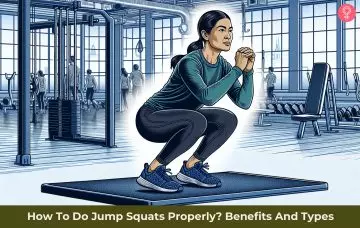
Image: Dall·E/StyleCraze Design Team
Jump squats are an amazing way to get fit! Watch this video to find out what happens to your body if you do them every day!
Personal Experience: Source
StyleCraze's articles are interwoven with authentic personal narratives that provide depth and resonance to our content. Below are the sources of the personal accounts referenced in this article.
i. Have you done 100 squats every day?https://medium.com/@amount/have-you-done-100-squats-every-day-10848485663
References
Articles on StyleCraze are backed by verified information from peer-reviewed and academic research papers, reputed organizations, research institutions, and medical associations to ensure accuracy and relevance. Read our editorial policy to learn more.
- The Effects of Multiple Sets of Squats and Jump Squats on Mechanical Variables, Journal of Strength and Conditioning Research, US National Library of Medicine, National Institutes of Health.
https://www.ncbi.nlm.nih.gov/pubmed/28759537 - Jump-Squat and Half-Squat Exercises: Selective Influences on Speed-Power Performance of Elite Rugby Sevens Players, PloS One, US National Library of Medicine, National Institutes of Health.
https://www.ncbi.nlm.nih.gov/pmc/articles/PMC5256944/ - Power versus strength-power jump squat training: influence on the load-power relationship, Medicine and Science in Sports and Exercise, US National Library of Medicine, National Institutes of Health.
https://www.ncbi.nlm.nih.gov/pubmed/17545891 - Exercise and type 2 diabetes: molecular mechanisms regulating glucose uptake in skeletal muscle, Advances in Physiology Education, US National Library of Medicine, National Institutes of Health.
https://www.ncbi.nlm.nih.gov/pmc/articles/PMC4315445/ - Exercise and Regulation of Lipid Metabolism, Progress in Molecular Biology and Translational Science, US National Library of Medicine, National Institutes of Health.
https://www.ncbi.nlm.nih.gov/pubmed/26477910 - Health benefits of physical activity: the evidence, Canadian Medical Association Journal, US National Library of Medicine, National Institutes of Health.
https://www.ncbi.nlm.nih.gov/pmc/articles/PMC1402378/ - Exercise and renal function, Sports Medicine, US National Library of Medicine, National Institutes of Health.
https://www.ncbi.nlm.nih.gov/pubmed/6567229





